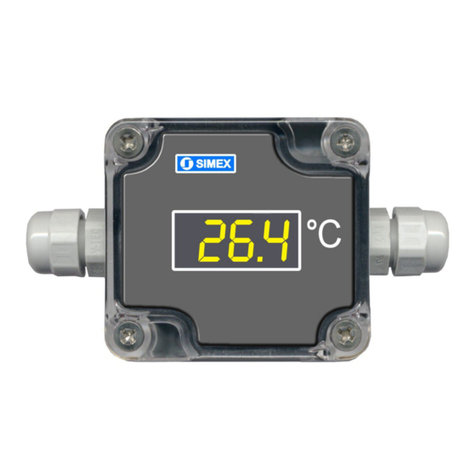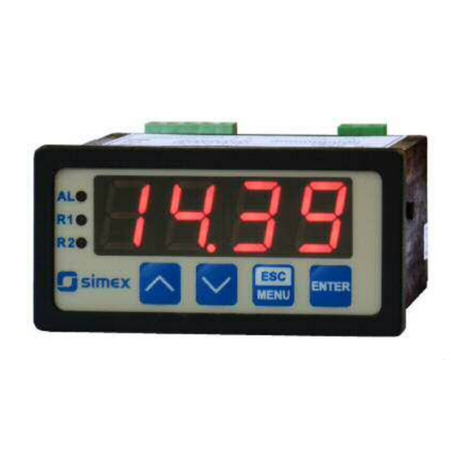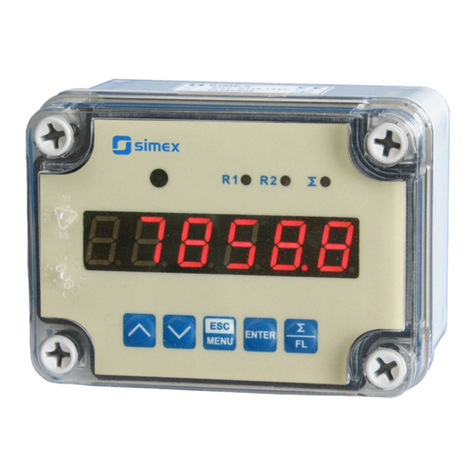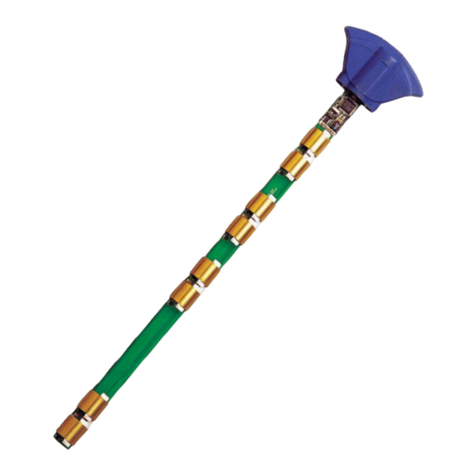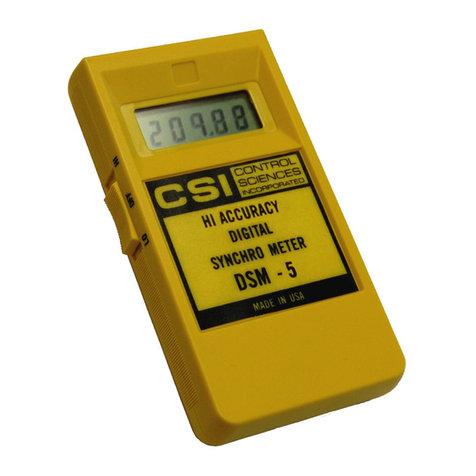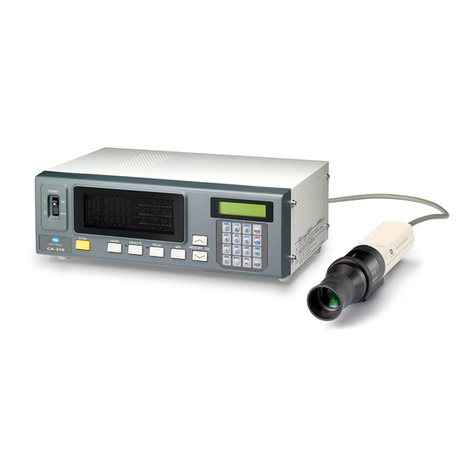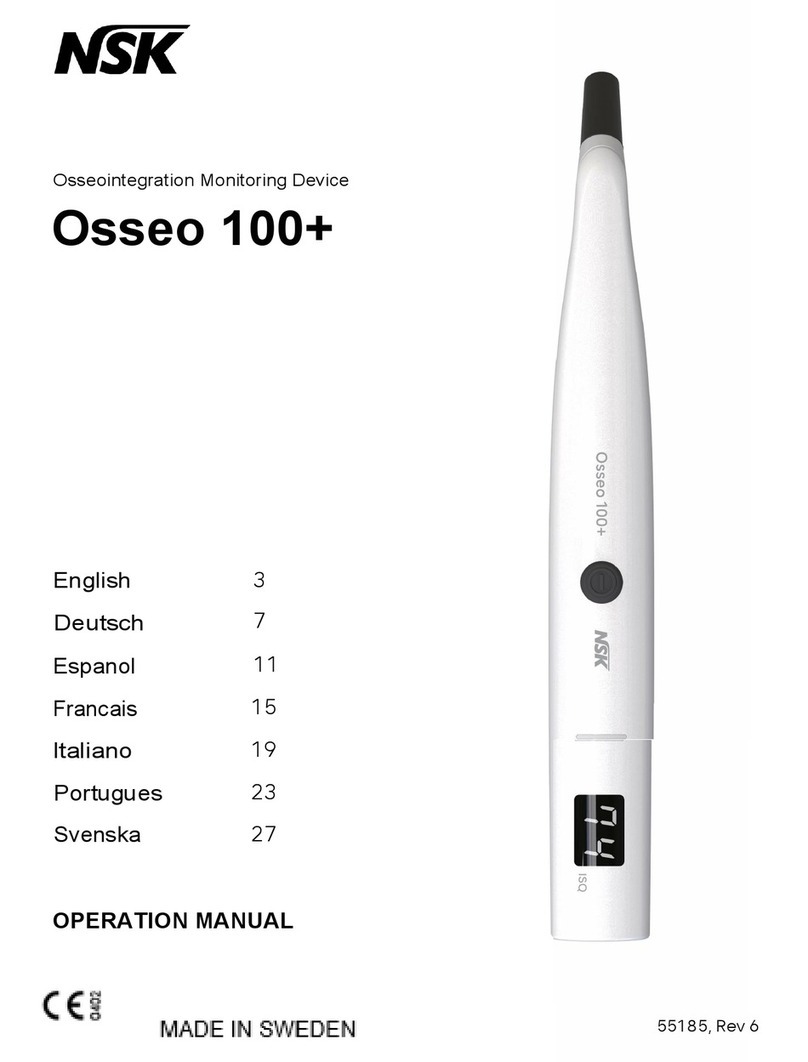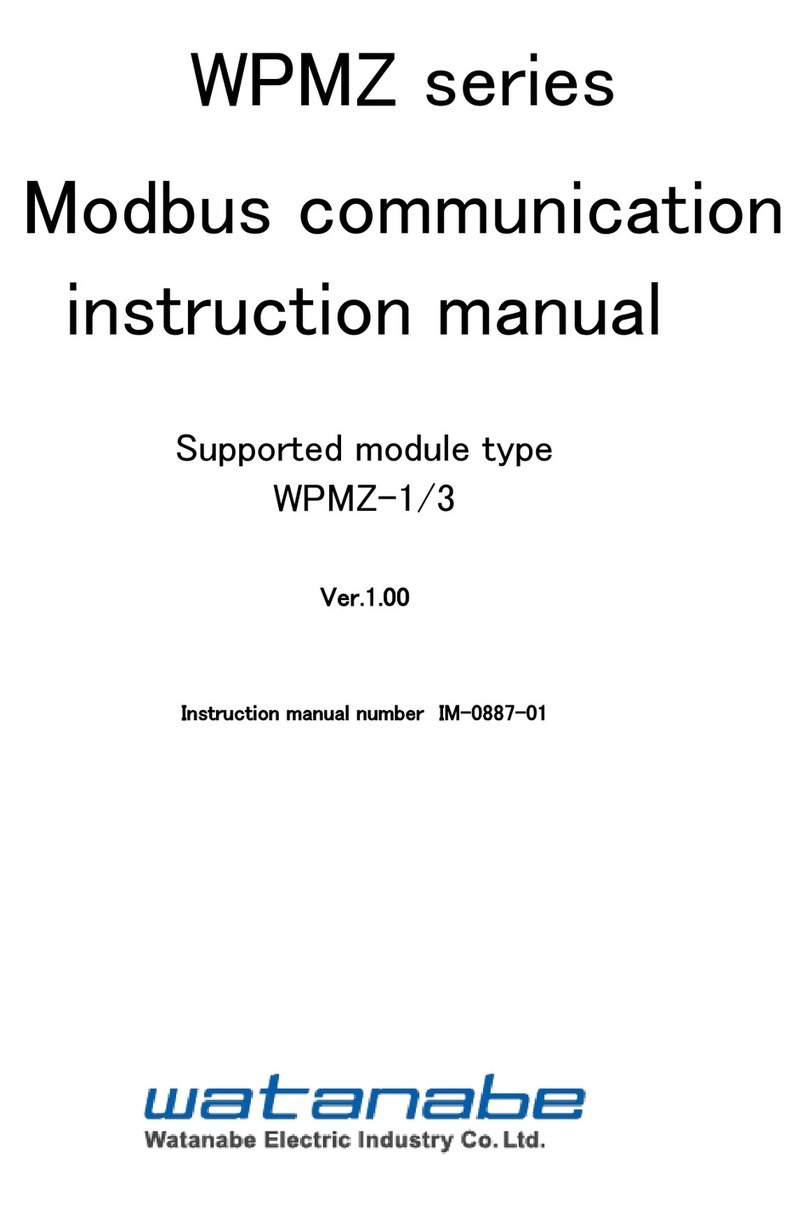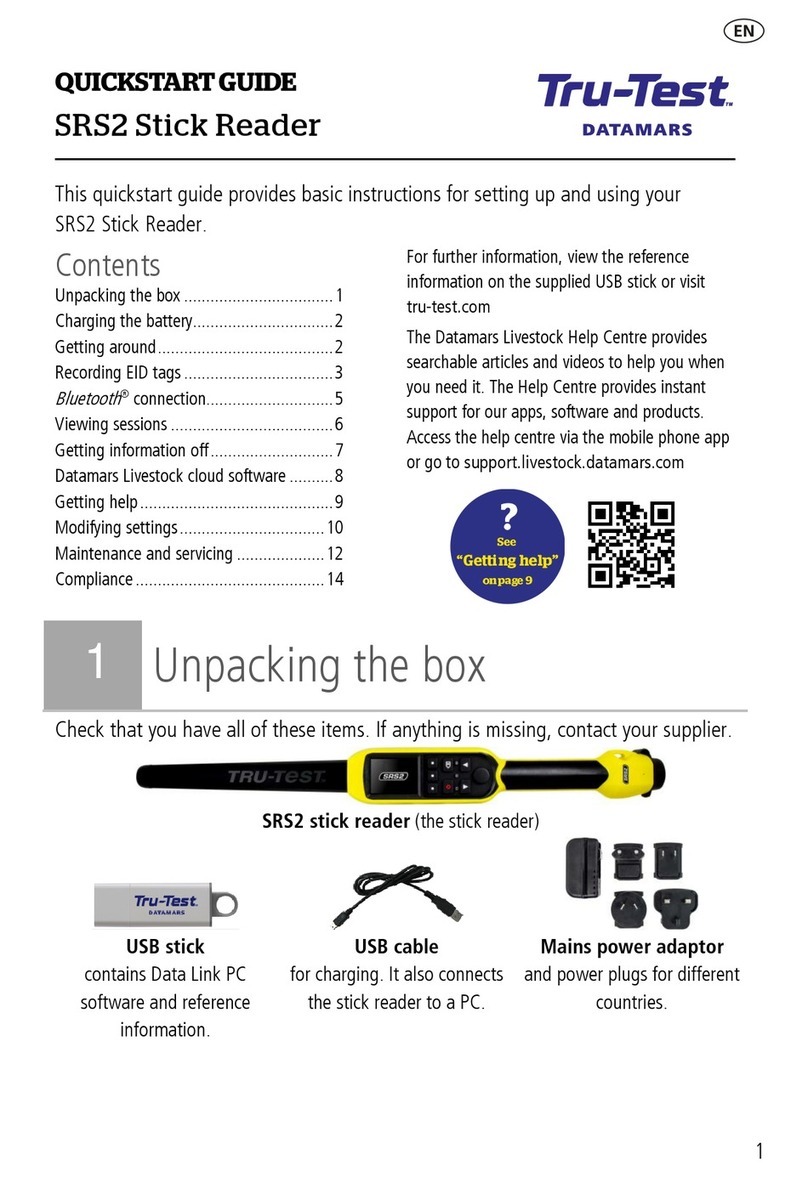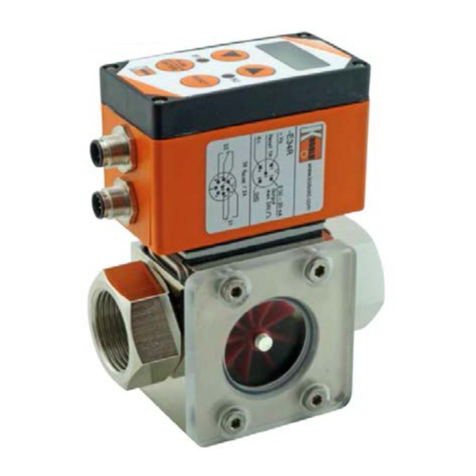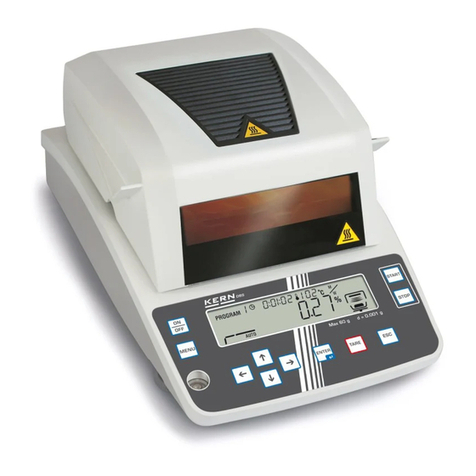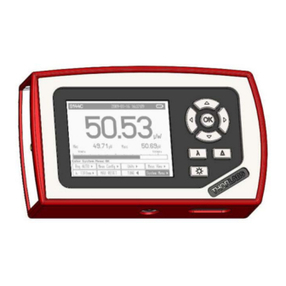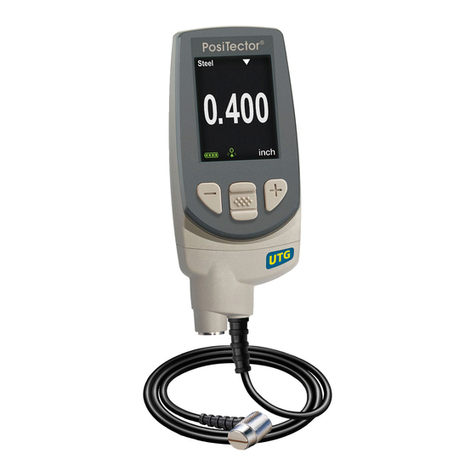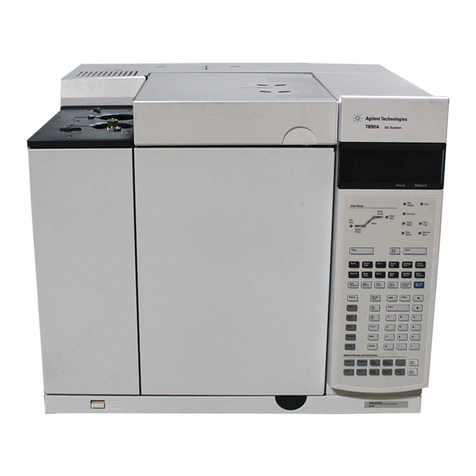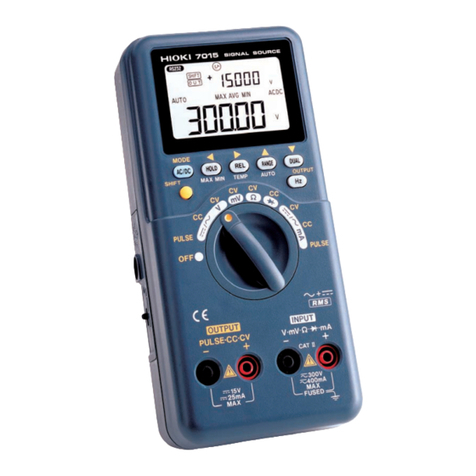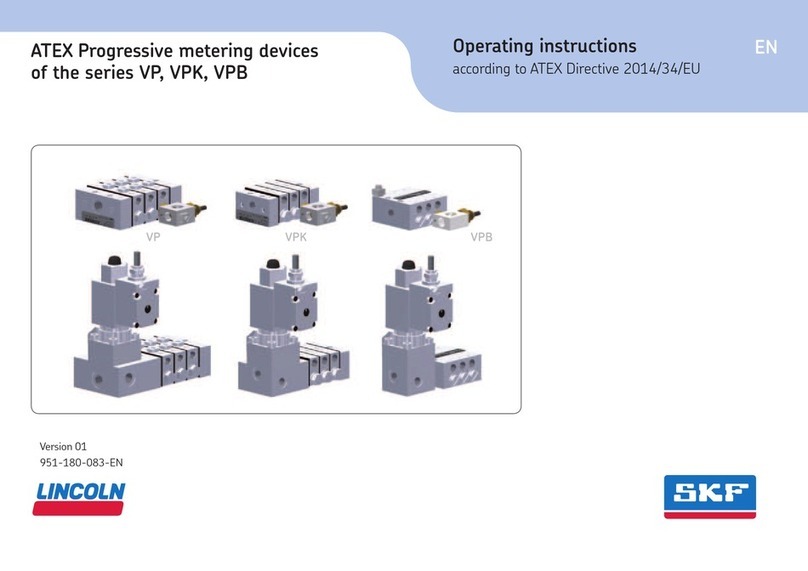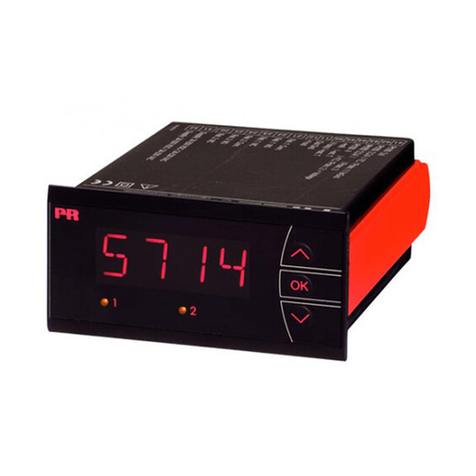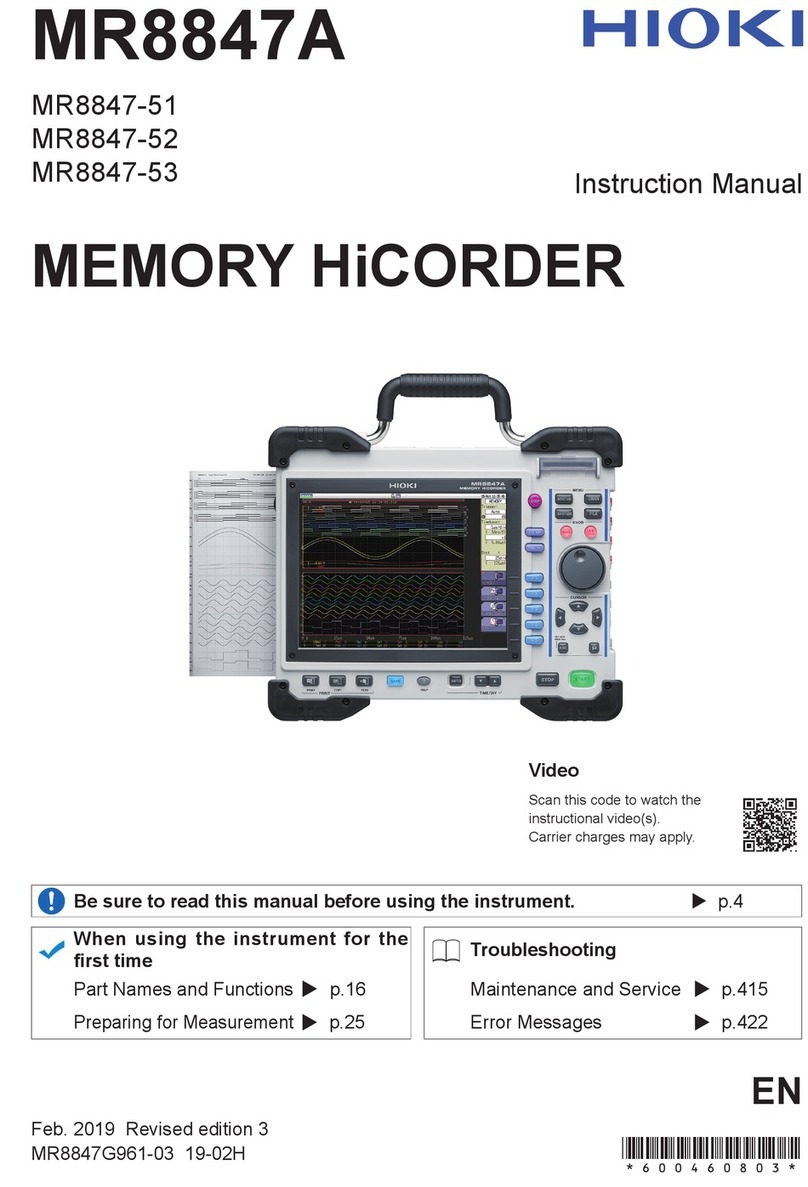Simex SIMPACT SWE-73-A User manual

User manual for digital indicator with U/I input SWE-73-A
CONTENTS
1. BASIC REQUIREMENTS AND USER SAFETY.........................................................................................3
2. GENERAL CHARACTERISTICS................................................................................................................4
3. TECHNICAL DATA......................................................................................................................................4
4. DEVICE INSTALLATION.............................................................................................................................6
4.1. UNPACKING.......................................................................................................................................6
4.2. ASSEMBLY.........................................................................................................................................6
4.3. CONNECTION METHOD...................................................................................................................8
4.4. MAINTENANCE................................................................................................................................11
5. DESCRIPTION OF IR REMOTE CONTROLLER AND CONTROL SOFTWARE PUSH-BUTTONS......12
6. PRINCIPLE OF OPERATION....................................................................................................................12
6.1. MEASUREMENT MODE..................................................................................................................12
6.2. DETECTION OF THE PEAK VALUES.............................................................................................14
. DEVICE PROGRAMMING.........................................................................................................................14
7.1. PROGRAMMING MENU...................................................................................................................14
7.2. PARAMETERS EDITION..................................................................................................................15
7.2.1. N meric parameters (digit change mode)...............................................................................15
7.2.2. N meric parameters (slide change mode)..............................................................................15
7.2.3. Switch parameters (“LIST” type)..............................................................................................16
7.3. MENU DESCRIPTION......................................................................................................................17
7.3.1. “inPt” men ..............................................................................................................................17
7.3.2. ”bri” parameter.........................................................................................................................19
7.3.3. ”HOLd” men ...........................................................................................................................20
7.3.4. ”Scod” parameter.....................................................................................................................20
7.3.5. ”rS” men .................................................................................................................................20
7.3.6. ”Edit” parameter.......................................................................................................................21
7.3.7. ”dEFS” parameter....................................................................................................................21
7.3.8. ”SErv” men .............................................................................................................................21
7.4. MENU STRUCTURE........................................................................................................................22
8. OVER-CURRENT PROTECTION..............................................................................................................23
9. DISPLAYED VALUES CALCULATION....................................................................................................23
9.1. ADDITIONAL CALCULATIONS (USED CONVERSION CHARACTERISTIC)................................23
9.1.1. Linear characteristic................................................................................................................23
9.1.2. Sq are characteristic...............................................................................................................24
9.1.3. Sq are root characteristic........................................................................................................24
9.1.4. User defined characteristic......................................................................................................25
9.2. EXAMPLES OF CALCULATIONS....................................................................................................26
10. THE MODBUS PROTOCOL HANDLING................................................................................................29
10.1. LIST OF REGISTERS.....................................................................................................................29
10.2. TRANSMISSION ERRORS DESCRIPTION...................................................................................31
10.3. EXAMPLES OF QUERY/ANSWER FRAMES................................................................................31
11. DEFAULT AND USER'S SETTINGS LIST..............................................................................................34
2

User manual for digital indicator with U/I input SWE-73-A
Explanation of symbols used in the manual:
- This symbol denotes especially important g idelines concerning the installation and
operation of the device. Not complying with the g idelines denoted by this symbol
may ca se an accident, damage or eq ipment destr ction.
IF THE DEVICE IS NOT USED ACCORDING TO THE MANUAL THE USER IS
RESPONSIBLE FOR POSSIBLE DAMAGES.
- This symbol denotes especially important characteristics of the nit.
Read any information regarding this symbol caref lly
1. BASIC REQUIREMENTS AND USER SAFETY
- Th manufactur r is not r sponsibl for any damag s caus d by
inappropriat installation, not maintaining th prop r t chnical condition
and using th unit against its d stination.
- Installation should be conducted by qualified personnel . During installation all
available safety requirements should be considered. The fitter is responsible for
executing the installation according to this manual, local safety and EMC
regulations.
- The unit must be properly set-up, according to the application. Incorrect
configuration can cause defective operation, which can lead to unit damage or
an accident.
- If in th cas of a d f ct of unit op ration th r is a risk of a s rious thr at
to th saf ty of p opl or prop rty additional, ind p nd nt syst ms and
solutions to pr v nt such a thr at must b us d.
- Th unit us s dang rous voltag that can caus a l thal accid nt. Th unit
must b switch d off and disconn ct d from th pow r supply prior to
starting installation of troubl shooting (in th cas of malfunction).
- Neighbouring and mating equipment must meet the requirements of appropriate
standards and regulations concerning safety and be equipped with adequate
anti-overvoltage and anti-interference filters.
- Do not att mpt to disass mbl , r pair or modify th unit yours lf. Th unit
has no us r s rvic abl parts. Units, in which a d f ct was stat d must b
disconn ct d and submitt d for r pairs at an authoriz d s rvic c ntr .
- In order to minimize fire or electric shock hazard, the unit must be protected
against atmospheric precipitation and excessive humidity.
- Do not use the unit in areas threatened with excessive shocks, vibrations, dust,
humidity, corrosive gasses and oils.
- Do not use the unit in explosion hazard areas.
3
i
!
!
!

User manual for digital indicator with U/I input SWE-73-A
- Do not use the unit in areas with significant temperature variations, exposed to
condensation or icing.
- Do not use the unit in areas exposed to direct sunlight.
- Make sure that the ambient temperature (e.g. inside the control box) does not
exceed the recommended values. In such cases forced cooling of the unit must
be considered (e.g. by using a ventilator).
Th unit is d sign d for op ration in an industrial nvironm nt and must not
b us d in a hous hold nvironm nt or similar.
2. GENERAL CHARACTERISTICS
The SWE-73-A is a simple digital panel indicator, equipped with two measurement inputs.
One current input ( -2 /4-2 mA) and one voltage input ( -5/1-5/ -1 /2-1 V). Current input has
additionally overcurrent protection circuit, which protects standard resistor.
The selection of active input is realised by software, and selected input can be changed
at any time. Additionally the SWE-73-A allows user to select a conversion characteristic of
several kinds: linear, square, square root, and user defined (max.2 points length). Result is
showed on 4-digit LED display. Displayed values range can be selected by user, from -999 to
9999, plus decimal point. Device SWE-73-A is equipped with RS-485 / Modbus RTU
communication interface .
The measurement range, active input and other parameters can be selected while
ordering. The device can be configured via IR remote controller or, optionally by PC via
RS-485 interface, or using simple RS-232 to IR converter. Moreover communication interface
RS-485 enables data transmission in any monitoring system equipped witch Modbus RTU
protocol.
Easy assembling, small dimensions, precision and reliability are the basic trumps of SWE-73-
A indicators.
IR remote controller is not a part of the SWE-73-A and must be ordered separately.
3. TECHNICAL DATA
Power supply voltage
(depending on version)
External fuse (required)
Power consumption
23 V AC ±1 %; 5 ÷ 6 Hz
or 11 V AC ± 1 %, 5 ÷ 6 Hz
or 24V DC (not separated)
T - type, max. 2 A
max. 1,5 VA @ 23 V AC and @ 11 V AC
max. 1 W @ 24V DC
Current input ÷2 mA, 4÷2 mA overload protected,
maximum input current about 5 mA
Current measurement accuracy ± .25% ± one digit (for ÷2 mA range)
Current input resistance ~ 5 Ω
Voltage input ÷5 V, 1÷5 V, ÷1 V, 2÷1 V
4
!
!

User manual for digital indicator with U/I input SWE-73-A
Voltage measurement accuracy ± .25% ± one digit (for ÷1 V range)
Voltage input resistance ~ 1 kΩ
Display range -999 ÷ 9999, plus decimal point
Accepted prolonged input overload: 2 %
Communication interface RS 485, 8N1 and 8N2, Modbus RTU, not separated
Baud rate 12 bit/s ÷ 1152 bit/s
Display LED, 4 digit, 13mm height, red
Data memory non-volatile memory, EEPROM type
Protection level IP 4 (from front)
IP 2 (housing and connection clips)
Housing type
Housing material
Housing dimensions
panel
NORYL UL94V-
for 24V DC version: 72 x 36 x 77 mm
for 23 V AC version: 72 x 36 x 94 mm
Mounting hole
Assembly depth
67 x 32,5 mm
for 24V DC version: min. 78 mm
for 23 V AC version: min. 95 mm
Panel thickness max. 5 mm
Operating temperature
(depending on version)
°C to +5 °C
or -2 °C to +5 °C
Storage temperature
(depending on version)
-1 °C to +7 °C
or -2 °C to +7 °C
Humidity
Altitude
5 to 9 % no condensation
up to 2 meters above sea level
Screws tightening max. torque ,5 Nm
Max. connection leads diameter 2,5 mm2
Safety requirements according to: PN-EN 61 1 -1
installation category: II
pollution degree: 2
voltage in relation to ground: 3 V AC
insulation resistance: >2 MΩ
insulation strength between power supply and
input/output terminal: 1min. @ 23 V
EMC according to: PN-EN 61326
This is a class A unit. In housing or a similar ar a it can caus radio
fr qu ncy int rf r nc . In such cas s th us r can b r qu st d to us
appropriat pr v ntiv m asur s.
!

User manual for digital indicator with U/I input SWE-73-A
4. DEVICE INSTALLATION
The unit has been designed and manufactured in a way assuring a high level of user
safety and resistance to interference occurring in a typical industrial environment. In order to
take full advantage of these characteristics installation of the unit must be conducted correctly
and according to the local regulations.
- Read the basic safety requirements on page 3 prior to starting the installation.
- Ensure that the power supply network voltage corresponds to the nominal
voltage stated on the unit’s identification label.
- The load must correspond to the requirements listed in the technical data.
- All installation works must be conducted with a disconnected power supply.
- Protecting the power supply clamps against unauthorized persons must be
taken into consideration.
4.1. UNPACKING
After removing the unit from the protective packaging, check for transportation damage. Any
transportation damage must be immediately reported to the carrier. Also, write down the unit
serial number on the housing and report the damage to the manufacturer.
Attached with the unit please find:
- user’s manual,
- warranty,
- assembly brackets - 2 pieces.
4.2. ASSEMBLY
- The unit is designed for mounting indoor inside housings (control panel,
switchboard) assuring appropriate protection against electric impulse waves.
Metal housing must be connected to the grounding in a way complying with the
governing regulations.
- Disconnect the power supply prior to starting assembly.
- Check the correctness of the performed connections prior to switching the unit on.
In order to assembly the unit, a 67 x 32.5 mm mounting hole (Figure 4.1) must be
prepared. The thickness of the material of which the panel is made must not exceed
5mm. Place the unit in the mounting hole inserting it from the front side of the panel,
and then fix it using the brackets (Figure 4.2). The minimum distances between
assembly holes’ axes - due to the thermal and mechanical conditions of operation -
are 91 mm x 57mm (Figure 4.3).
6
!
!
!

User manual for digital indicator with U/I input SWE-73-A
4.3. CONNECTION METHOD
Caution
- Installation should be conducted by qualified personnel . During installation all
available safety requirements should be considered. The fitter is responsible for
executing the installation according to this manual, local safety and EMC
regulations.
- The unit is not equipped with an internal fuse or power supply circuit breaker.
Because of this an external time-delay cut-out fuse with minimal possible nominal
current value must be used (recommended bipolar, max. 2A) and a power supply
circuit-breaker located near the unit. In the case of using a monopolar fuse it must
be mounted on the phase cable (L).
- The power supply network cable diameter must be selected in such a way that in
the case of a short circuit of the cable from the side of the unit the cable shall be
protected against destruction with an electrical installation fuse.
- Wiring must meet appropriate standards and local regulations and laws.
- In order to secure against accidental short circuit the connection cables must be
terminated with appropriate insulated cable tips.
- Tighten the clamping screws. The recommended tightening torque is .5 Nm.
Loose screws can cause fire or defective operation. Over tightening can lead to
damaging the connections inside the units and breaking the thread.
- In the case of the unit being fitted with separable clamps they should be inserted
into appropriate connectors in the unit, even if they are not used for any
connections.
- Unus d clamps (mark d as n.c.) must not b us d for conn cting any
conn cting cabl s ( .g. as bridg s), b caus this can caus damag to th
quipm nt or l ctric shock.
- If the unit is equipped with housing, covers and sealing packing, protecting
against water intrusion, pay special attention to their correct tightening or clamping.
In the case of any doubt consider using additional preventive measures (covers,
roofing, seals, etc.). Carelessly executed assembly can increase the risk of electric
shock.
- After the installation is completed do not touch the unit’s connections when it is
switched on, because it carries the risk of electrical shock.
Du to possibl significant int rf r nc in industrial installations appropriat m asur s
assuring corr ct op ration of th unit must b appli d. To avoid th unit of improp r
indications k p r comm ndations list d b low.
–Avoid common (parallel) leading of signal cables and transmission cables together with
power supply cables and cables controlling induction loads (e.g. contactors). Such cables
should cross at a right angle.
–Contactor coils and induction loads should be equipped with anti-interference protection
systems, e.g. RC-type.
8
!

User manual for digital indicator with U/I input SWE-73-A
–Use of screened signal cables is recommended. Signal cable screens should be
connected to the earthing only at one of the ends of the screened cable.
–In the case of magnetically induced interference the use of twisted couples of signal
cables (so-called “spirals”) is recommended. The spiral (best if shielded) must be used
with RS-485 serial transmission connections.
–In the case of interference from the power supply side the use of appropriate anti-
interference filters is recommended. Bear in mind that the connection between the filter
and the unit should be as short as possible and the metal housing of the filter must be
connected to the earthing with largest possible surface. The cables connected to the filter
output must not run in parallel with cables with interference (e.g. circuits controlling relays
or contactors).
Connections of power supply voltage and measurement signals are executed using the
screw connections on the back of the unit’s housing.
Fig re 4.4. Method of cable ins lation replacing and cable terminals
Fig re 4.5. Terminals description
All conn ctions must b mad whil pow r supply is disconn ct d !
9
!
9 10
GNDDATA+
DATA-
RS - 485
123456
GND
n.c.
0-20mA
4-20mA
+
7 8
n.c.
Pow r
supply
(depending on version)
0/1 - 5V
0/2 - 10V
GND +
6-7 mm
max. 2 mm

User manual for digital indicator with U/I input SWE-73-A
Fig re 4.6. Connection of power s pply
a) for 230V AC version; b) for 24V DC version
Fig re 4.7. Connection of 2-wire c rrent converters
Fig re 4.8. Connection of 3-wire c rrent converters
10
FUSE
230V AC
L N
L N
1 2
a)
FUSE
+ -
24V DC
1 2
+ -
b)
6 7 8 9 10
24V DC
- +
+
-
+
-
24V DC
- +
6 7 8 9 10

User manual for digital indicator with U/I input SWE-73-A
Fig re 4.9. Connection of voltage converters
4.4. MAINTENANCE
The unit does not have any internal replaceable or adjustable components available to
the user. Pay attention to the ambient temperature in the room where the unit is operating.
Excessively high temperatures cause faster ageing of the internal components and shorten the
fault-free time of unit operation.
In cases where the unit gets dirty do not clean with solvents. For cleaning use warm water with
small amount of detergent or in the case of more significant contamination ethyl or isopropyl
alcohol.
Using any other agents can cause permanent damage to the housing.
Product marked with this symbol should not be placed in municipal waste. Please
check local regulations for disposal and electronic products.
11
!
24V DC
+ -
-
+
+
6 7 8 9 10

User manual for digital indicator with U/I input SWE-73-A
5. DESCRIPTION OF IR REMOTE CONTROLLER AND CONTROL
SOFTWARE PUSH-BUTTONS
Symbols and functions of push-buttons:
Symbol used in the manual: [ESC/MENU]
Functions:
• Enter to main menu ( press and hold by at least 2 sec.)
• Exit the current level and Enter to previous menu (or measure mode)
• Cancel the changes made in parameter being edited
Symbol used in the manual: [ENTER]
Functions :
• Start to edit the parameter
• Enter to the sub-menu,
• Confirmation of changes made in parameter being edited
Symbol used in the manual: [^] [v]
Functions :
• Change of the present menu,
• Modification of the parameter value,
• Change of the display mode.
6. PRINCIPLE OF OPERATION
After turning the power supply on, device ID and software version are showed on the
display, next the controller goes to the measurement mode.
6.1. MEASUREMENT MODE
In the measure mode, the measurement results, converted over selected characteristic,
are displayed on the LED display. The measurement range equal to the nominal range is
called: nominal measurement range, and the measurement range equal to the extended
nominal range is called: permissible measurement range (Figure 6.1, 6.2).
12
MENU
ESC
ENTER
programming p shb ttons
infra-red
transmitter
MENU
ESC
ENTER

User manual for digital indicator with U/I input SWE-73-A
Fig re 6.1. Definitions of meas rement ranges in mode 4 ÷ 20mA
If the result of measurement exceeds the permissible measurement range, warning ”-Hi-” or
”-Lo-” is displayed rather than input signal, depends on exceeded value (see description of
“Lo r” i “Hi r” parameters, paragraph ”inPt” menu).
Fig re 6.2. Definitions of meas rement ranges in mode 0 ÷ 20mA
If the measurement value do not exceeds permissible measurement range but
displayed value exceeds range -999 ÷ 9999, the warning ”-Ov-” is displayed rather
than the calculated result.
Input type, range of displaying values, characteristic of conversion, decimal point position
and measure filtering ratio, are user configurable parameters. All accessible parameters can
be changed by entering the menu (see: DEVICE PROGRAMMING). Use the local keyboard or
the remote controller to do it. (Note: all parameters can be remote changed via RS-485
interface).
Configuration of the device (via menu or RS 485 interface) do not stops m asur s.
13
i
”Lo r” parameter ”Hi r” parameter
4 mA 2 mA
permissible measurement range
nominal measurement range
”Hi r” parameter
mA 2 mA
permissible measurement range
nominal measurement range
i

User manual for digital indicator with U/I input SWE-73-A
6.2. DETECTION OF THE PEAK VALUES
The SWE-73-A controller is equipped with peaks detection function. It can detect a peaks
of the input signal and display their values. Presets connected with this function are placed in
”HOLd” menu (see description of ”HOLd” menu). The detection of the peak can be done if
the measured signal raises and drops of value at least equal to parameter ”PEA”. Detected
peaks are displayed during the time defined by parameter ”timE”. If a new peak will be
detected while one is displayed, this new peak will be displayed and display time counter will
be cleared (Figure 6.3). If no peaks are detected while time ”timE” elapses, device starts to
show the current value of input signal again.
Fig re 6.3. Process of peaks detection
. DEVICE PROGRAMMING
The device menu allow user to set all parameters connected to operation of
measurement input, control modes, critical situations behaviour, communication via RS-485
and access settings. The meaning of the particular parameters is described in paragraph
MENU DESCRIPTION.
.1. PROGRAMMING MENU
To enter main menu (being in the measurement mode) operator must to press and hold
at least 2 sec. [ESC/MENU] button.
If the user password is defined (see parameter “Scod“), operator have to enter correct
one before proceeding to menu options . Entering of the passwords is similar to the edition of
numeric parameters (see: PARAMETERS EDITION ), however presently editing digit is showed
only on the display, other digits are replaced by “-” sign.
After entering of last digit of the password first menu position will be displayed (if the password
is correct) or warning ”Err” in other case.
14
”timE”
measure
time
”timE”
”PEA”
”PEA”
real measurement result
display value

User manual for digital indicator with U/I input SWE-73-A
Functions of the buttons while sub-menu and parameters choice:
Selection of sub-menu or parameter for editing. Name of selected item (sub-
menu or parameter) is displayed.
Operation of [ENTER] button depend on present menu position:
• if the name of some sub-menu is displayed - enter this sub-menu; name
of the first parameter (or next level sub-menu) is displayed,
• if the name of some parameter is displayed - enter the edition of this
parameter; present value of the parameter is displayed,
[ESC/MENU] button allow user to exit present menu level and goes to upper
level menu (or measurement mode).
After about 1 min. since last use of the buttons, device exits the menu mode and
returns to the measurement mode (only if no parameters are in editing mode).
.2. PARAMETERS EDITION
To start edition of any parameter user should select name of desired one using [^] [v]
buttons and then press [ENTER].
.2.1. Numeric parameters (digit change mode)
Numerical parameters are displayed as decimal numbers. The mode of its new value
entering depends on chosen edit method ( see parameter „Edit”).
In mode “by digit” („Edit”=”dig”) pressing one of the keys [^] or [v] causes change of
current position (flashing digit) or the sign (+/-). Short pressing of the [ENTER] button causes
change of the position (digit).
Press [ENTER] at least 2 seconds to accept the changes, after that question ”SEt?” is
displayed, and user must to confirm (or cancel) the changes. To conform changes (and story it
in EEPROM) press [ENTER] button shortly after ”SEt?” is displayed. To cancel the changes
press [ESC] button shortly after ”SEt?” is displayed. After that device returns to the menu.
.2.2. Numeric parameters (slide change mode)
In “slide change” mode („Edit”=”Slid”), buttons [^] and [v] has different functions.
To increase edited value press (or press and hold) [^] button only, the increasing became
quickest as long as button [^] is pressed. To slow down the increasing, button [v] can be
used. If [v] is pressed shortly (and button [^] is still pressed), increasing slow down for
a moment only, if [v] is pressed and held while button [^] is still pressed the increasing slow
down and will be kept on lower speed.
To decrease edited value press (or press and hold ) [v] button only. The decreasing
became quickest as long as button [v] is pressed. To slow down the decreasing, button [^]
can be used. If [^] is pressed shortly (and button [v] is still pressed), decreasing slow down for
a moment only, if [^] is pressed and held while button [v] is still pressed the decreasing slow
down and will be kept on lower speed.
Press [ENTER] at least 2 seconds to accept the changes, after that question ”SEt?” is
displayed, and user must to confirm (or cancel) the changes. To conform changes (and story it
1
i
ENTER
MENU
ESC

User manual for digital indicator with U/I input SWE-73-A
in EEPROM) press [ENTER] button shortly after ”SEt?” is displayed. To cancel the changes
press [ESC] button shortly after ”SEt?” is displayed. After that device returns to the menu.
.2.3. Switch parameters (“LIST” type)
Switch parameters can be described as a sets of values (a lists) out of which only one of
the options available on the list can be selected for the given parameter. Options of switching
parameter are selected using [^], [v] keys.
Short pressing of [ENTER] causes in displaying of the acknowledge question (”SEt?”). If
key [ENTER] is pressed again, the changes are accepted, stored in EEPROM end the edition
process finished. Pressing the key [ESC] after ”SEt?” causes in cancelling of made changes
and returning to menu.
Functions of buttons when editing numeric and switching parameters:
While editing numeric parameter:
• change of current (flashing) digit
• slide change of value (acceleration, deceleration, direction change)
While editing switch parameter - selection of switch parameter.
If numerical parameter is being edited, a short press of [ENTER] button
change edited position. A long press of [ENTER] button (at lest 2 sec.)
causes of display a ”SEt?” ask, which allow user to make sure if change of
the parameter value is correct. If switch parameter is being edited, a short
press of [ENTER] button causes of display a ”SEt?” ask. When [ENTER]
button is pressed again (while ”SEt?” is displayed) the new value of the
parameter is stored in EEPROM memory.
Pressing this button operator can cancel the changes done up to now (if they
were not approved by [ENTER] button after the ”SEt?” ask) and come back
to menu
16
MENU
ESC
ENTER

User manual for digital indicator with U/I input SWE-73-A
.3. MENU DESCRIPTION
“- - - -” - password checking. If some password different from „0000” is set, then every
enter to main menu follows the entering of password. If entered password is
correct then first menu position will be displayed else warning ”Err”, and unit
returns to measurement mode.
Due to problem with direct displaying of “m” letter, it is exchanged with special sign
“ “. Independently in user manual letter „m” is used to make it more readable
(example: “modE”).
.3.1. “inPt” menu
This menu presets the measurement input:
“tYPE" - type of the input / sensor. This parameter can be set to values:
”0-20”, “4-20”- current inputs.
”0-10”, “2-10”, ”0-5”, “1-5”- voltage inputs.
Displayed values are defined by parameters “Lo C”,”Hi C” (or by user defined
characteristic points) and parameter ”Pnt”.
”CHAr” - this option presets type of the conversion characteristic, and can be set to:
”Lin” - linear
“Sqr” - square
“Sqrt” - square root
When one of those characteristics is chosen display
range is defined by “Lo C” and “Hi C”.
“USEr” - user defined characteristic. Maximal length 2 points. Every point is
defined by user. Adding, Editing and Deleting of points is done by options
„AddP”, „EdtP”, „dELP” („InPt” menu) respectively.
If user defined characteristic is selected, and if number of defined points is lower
than 2 then warning ”Errc” is displayed in measurement mode.
The process of displayed result calculation is described in details in DISPLAY VALUES
CALCULATION paragraph.
”FiLt” - this parameter sets filtration rate. It can be set to values from (no filtration ) to 5
(strongest filtration – time window about 2 sec).
”Pnt” - decimal point position. It can be set to one of:
“ 0”, “ 0.0”, “ 0.00”, “0.000”
Decimal point position is changed by [^], [v] buttons.
17
i
i

User manual for digital indicator with U/I input SWE-73-A
“Lo C”
“Hi C”
These parameters describe the values displayed for minimum and maximum input
current. For example, if input type is set to 4-2 mA “Lo C” parameter defines the
value displayed when input current is equal 4 mA, and “Hi C” parameter defines
the value displayed for 2 mA of input current. Available range for these
parameters: -999 ÷ 9999. Negative values can be set by entering '-' sign on the first
position (by use of [^], [v] buttons).
If user defined characteristic is selected (parameter “CHAr” = ”USEr”) the
parameters „Lo C” and „Hi C” are not available for modification, due to their values
are calculated from defined characteristic.
“AddP” - this menu allow user to add single point to the user defined characteristic.
After selection of this option device waits for „X” and „Y” coordinates of new point.
Modification of the coordinates is done accordingly to numerical parameters edition.
Coordinate „X” defines the percentage ratio of input current to selected current
range. The „X” range: -99,9 ÷ 199,9. Coordinate „Y” defines displayed value for
particular „X” value. The „Y” value can be changed in range: -999 ÷ 9999, decimal
point position depend on „Pnt” parameter (menu ”inPt ”).
• User can not enter two points with the same value of „X” coordinate. If user trays
to do it, ”Err” warning is displayed. To modify any defined point use ”EdtP”
option.
• To distinguish „X” and „Y” coordinates, if „X” coordinate is displayed an
additional decimal point on utmost right position is displayed.
• If user defined characteristic is selected, and if number of defined points is lower
than 2 then warning ”Errc” is displayed in measurement mode.
“dELP” - this option allows user to delete any of the points of the user defined
characteristic. After selection current number of points of the user defined
characteristic is displayed for about approx. 1.5 sec. After that device waits for
selection of point being deleted (by [^], [v] buttons). The short pressing of [ENTER]
button causes by switching between X and Y value of the displayed point. The long
press (press and hold at least 2 sec) of [ENTER] button causes by displaying
„dEL?” ask. If [ENTER] button is pressed again, current point is deleted and new
updated number of points of the user defined characteristic is displayed.
“EdtP” - this option allows user to modify of particular point of the user defined
characteristic. After selection current number of points of the user defined
characteristic is displayed for about approx. 1.5 sec. After that device waits for
selection of point being edited (by [^], [v] buttons). The short pressing of [ENTER]
button causes by switching between X and Y value of the displayed point. The long
press (press and hold at least 2 sec) of [ENTER] button causes by entering to edit
the selected coordinate of the point. Modification of the coordinates is done
accordingly to numerical parameters edition.
“AddP”, ”dELP” and “EdtP” options are available only if the user defined
characteristic is used (it means when parameter “CHAr” = ”USEr”).
“Lo r”, ”Hi r” - these parameters define the expansion of nominal range in percent. They
18
i
i
i

User manual for digital indicator with U/I input SWE-73-A
determine the permissible range of input signal (Figure 7.1).
The permissible range allow user to exceed the nominal range of input signal.
If input value is contained in the permissible range a proper result is displayed.
If input signal exceeds this range (defined by “Lo r” and “Hi r”), “-Lo-” or “-
Hi-” warning is displayed depend on input signal value.
Fig re 7.1 Example of definition of permissible range of inp t signal -
“Lo r” and “Hi r” parameters (“4-20” mode)
The “Lo r” parameter is important if input is set to “4-20”, “1-5” or “2-10” mode
only, and determines lower border of the permissible range. If input is set to
“0-20”, “0-5” or “0-10” mode then lower border of the permissible range is
always .
For example if input is set to “4-20” mode, then lower border is calculated due to
expression: Imin = 4 mA - 4 mA × “Lo r” %.
The “Lo r” value can be set from to 99.9%.
Parameter “Hi r” determines the upper border of the permissible range accordingly
to the expression (for all modes).
For example if input is set to “4-20” mode, then upper border is calculated due to
expression: Imax = 2 mA + 2 mA × “Hi r” %.
The value of “Hi r” can be set from to 19.9%
In example no 1 of the DISPLAY VALUES CALCULATION paragraph the
procedure of the permissible input range determining is presented in details.
If the measurement value do not exceeds permissible measurement range but
displayed value exceeds range -999 ÷ 9999, the warning ”-Ov-” is displayed rather
than the calculated result.
.3.2. ”bri” parameter
This parameter allows user to set bright of the LED display, bright can be set to
conventional values from 1 to 8.
19
”Lo r” = 75, % (3 mA) ”Hi r” = 5, % (1 mA)
421
permissible measurement range
measurement result is displayed
regardless on nominal range exceeding
nominal measurement range (4-2 mA)
[mA]
2 221
Imin Imax
display
message ”-Lo-”
display
message ”-Hi-”
i

User manual for digital indicator with U/I input SWE-73-A
.3.3. ”HOLd” menu
This menu contains parameters connected with peak detection function. See also full
description of the peak detection function in paragraph: DETECTION OF THE PEAK VALUES
“modE” - the type of detected changes of the input signal, can be set to values:
”norm” - peaks, peak and next drop of the input signal of value equal at least “PEA”,
”inv” - drops, drop and next peak of the input signal of value equal at least “PEA”,
“PEA” - minimal detected signal change classified as peak or drop (see Figure 6.3)
“timE” - maximum time of displaying of the peak (drop) value, can be set from .1 to 19.9
sec, with .1 sec. resolution
“HdiS” - type of displayed values:
”rEAL” - current value is displayed,
”HOLd” - peak (drop) value is displayed,
.3.4. ”Scod” parameter
This parameter defines user password (4-digits number). If this parameter is set at value
“0000”, user password is turned off.
If th us r do not r m mb r his password, th acc ss to th m nu is possibl
by th “on -us password”. To g t this password pl as contact with
Mark ting Division. “Singl us password” can b us d only on tim , aft r
that it is d stroy d. Ent ring this password caus s in cl aring of us r
password, it m ans s ts th us r password to „0000”.
The “one-use password” can be used ONE TIME ONLY, it is impossible to use it
again! The “one-use password” can be restored by Service Division only.
.3.5. ”rS” menu
This menu is connected with RS-485 interface, and sets his properties:
”Addr” - this parameter defines the address of the device, accordingly to Modbus protocol.
It can be set in range from to 199. If the value is set then device, responds to
frames with address 255 (FFh).
”bAud” - this parameter determines RS-485 interface baud rate. It can be set to one of 8
possible values: ”1.2”, ”2.4”, ”4.8”, ”9.6”, ”19.2”, ”38.4”,”57.6”,”115.2”, which
respond to the baud rates of 12 , 24 , 48 , 96 , 192 , 384 , 576 and
1152 bit/s respectively.
20
i
Table of contents
Other Simex Measuring Instrument manuals
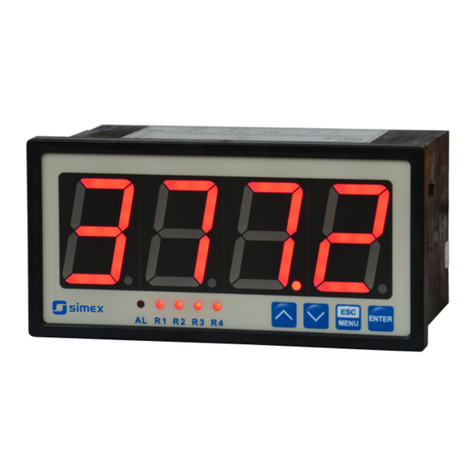
Simex
Simex SRP-147-1821-1-4-001 User manual

Simex
Simex SUR-94 User manual
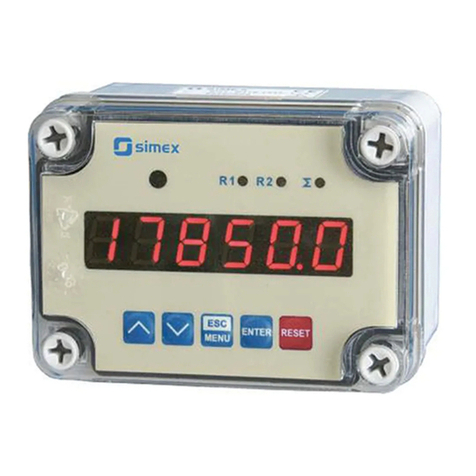
Simex
Simex SRP-N1186 User manual
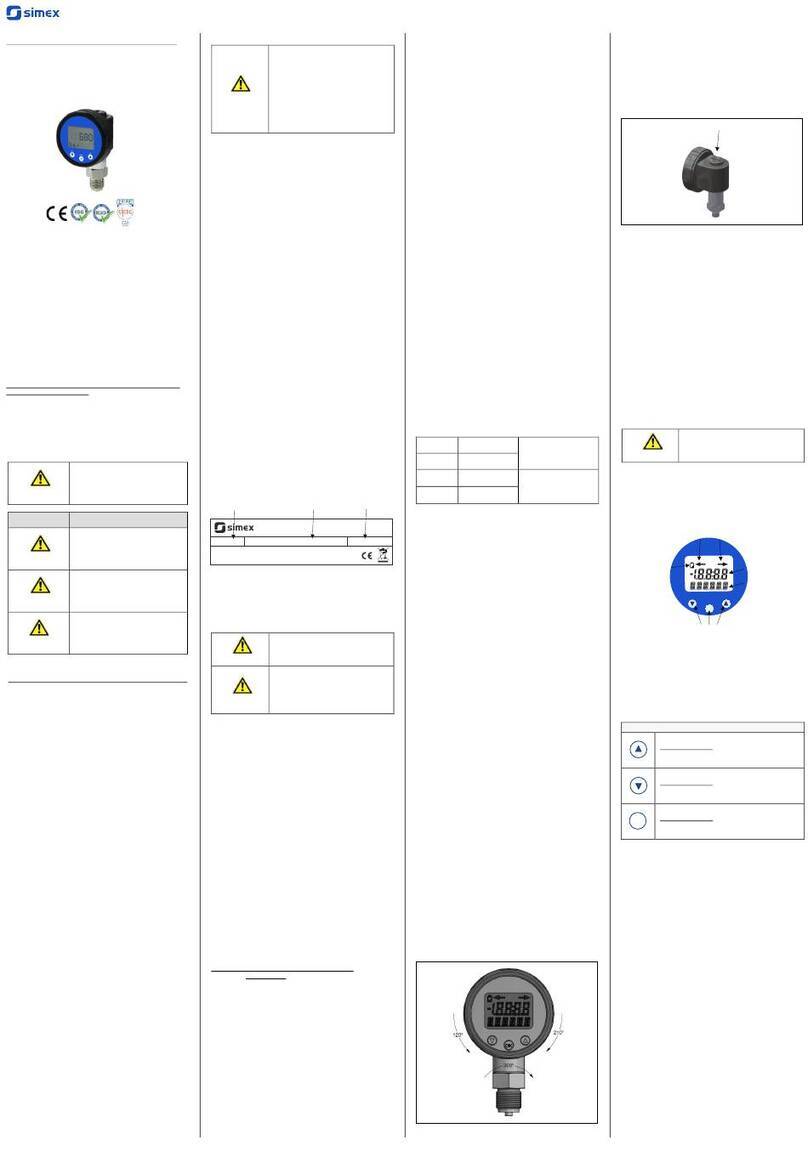
Simex
Simex CCM-P-02 User manual
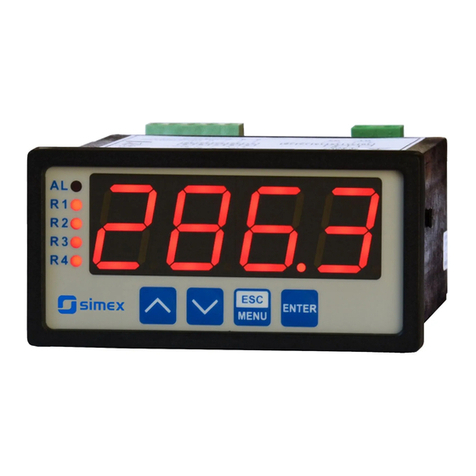
Simex
Simex SRT-94 User manual
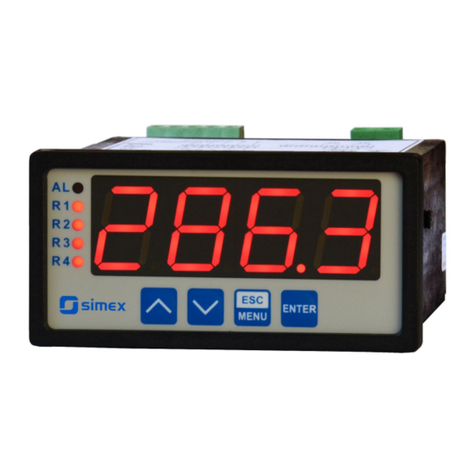
Simex
Simex SRP-94 User manual

Simex
Simex SPI-638 User manual

Simex
Simex SRT-N118-XA User manual
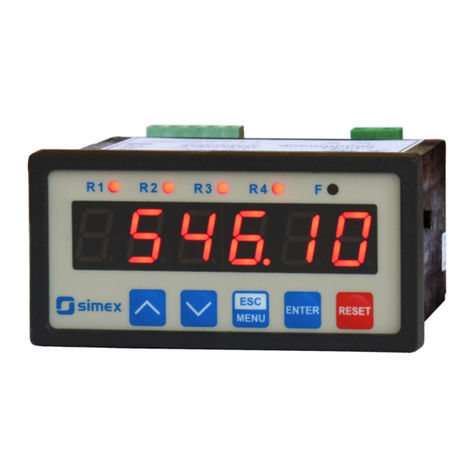
Simex
Simex SRP-946 User manual

Simex
Simex SRL-49 User manual
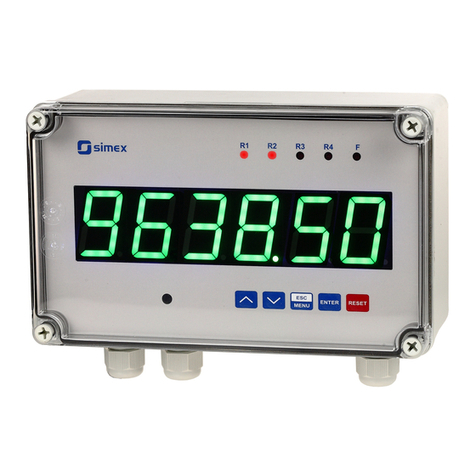
Simex
Simex STI-638 User manual
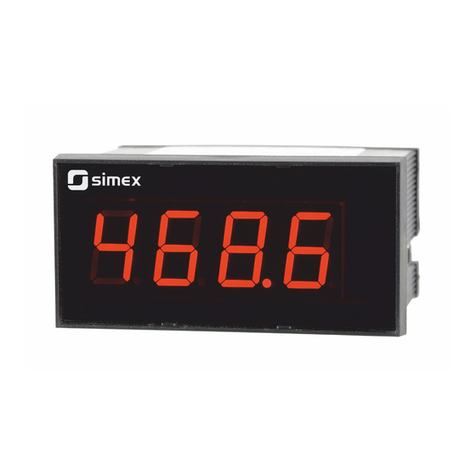
Simex
Simex SWE-94-U User manual
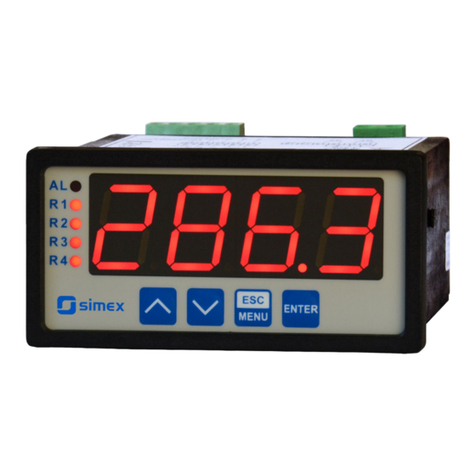
Simex
Simex SRT-94-XA User manual
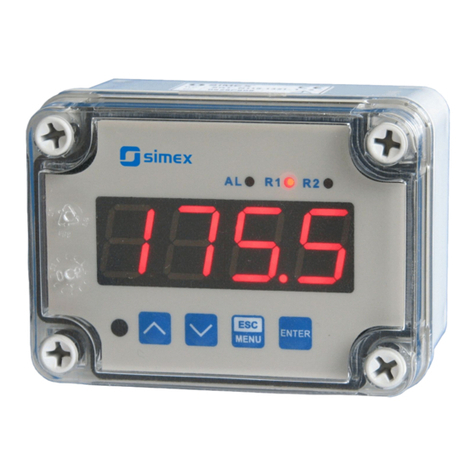
Simex
Simex SRP-N118 User manual

Simex
Simex SRP-147-XC User manual
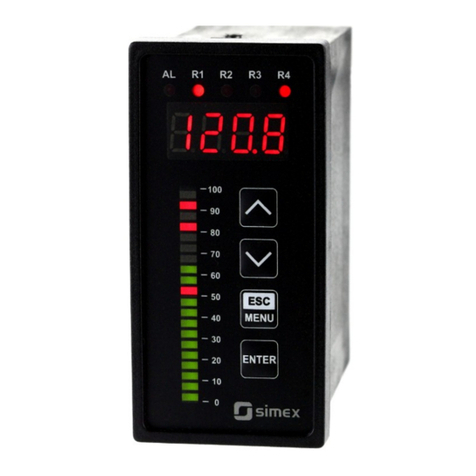
Simex
Simex SUR-49B User manual
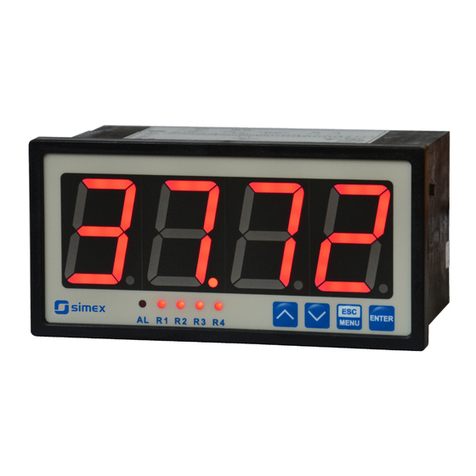
Simex
Simex SRT-147 User manual

Simex
Simex SPI-73 User manual
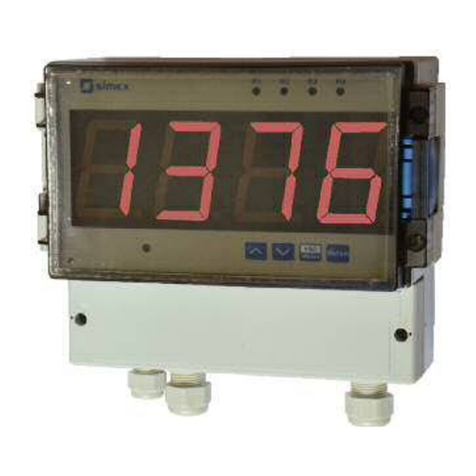
Simex
Simex SRT-457 User manual

Simex
Simex SUR-W410 User manual


